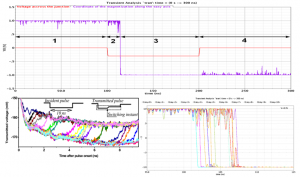Overview
The team is dedicated to the evaluation of the benefits of using magnetic devices in Integrated Circuits (ICs). It is expected that integrating non-volatility in ICs could contribute to push forward the incoming limits in the microelectronics scaling. This work includes integrating the magnetic devices in standard design tools, design hybrid circuits and evaluate their performance for various applications. The unique combination of advantages of spintronics devices (non-volatility associated with high speed and endurance, analogue capabilities, well controlled stochastic behavior…) allows intrinsically mixing the memory and logic functionalities (in Memory Computing). This opens the way towards new computing paradigms, beyond the standard Von-Newman architecture of computing systems. The most interesting applications addressed in the team are described below.
Research topics
Hybrid CMOS/Magnetic design flow

Designing hybrid circuits requires integrating the magnetic devices in the standard design flow of microelectronics. This includes compacts models for electrical simulations, technology files including the magnetic back-end and libraries of Standard Cells for digital design.
Low-power logic circuits

One issue related to microelectronics scaling is the increasing standby power, due to leakage currents. Introducing non-volatility in circuits allows easing the power gating technique, which consists in cutting-off the power supply of inactive blocks to save leakage.
Artificial intelligence

Spiking Neural Networks are seen as a Key building block for strongly improving the energy efficiency of current AI applications and opening up new possibilities (in terms of unsupervised learning, recurrent networks, probabilistic inference, etc.). The scientific challenges to be tackled are the following: the first one is to define power-constrained learning and inference algorithms (online, supervised, unsupervised, probabilistic, etc.). The second one is to design a scalable and flexible SNN architecture, adaptable to the different above-mentioned algorithms, and fabricate that circuit in hybrid nanoscale CMOS and NVM technology, enabling very dense synaptic density. The last objective is to derive a principled toolchain for the algorithm, design, development, and integration of spiking neural networks for future adoption in industrial health and automotive embedded applications.
IC Reliability : Hardware security

While STT MRAM can be beneficial for hardware security (taking advantage of its stochastic behavior for cryptography for instance), it also presents some specific failures mechanisms that has to be studied to take the appropriate countermeasures.
IC Reliability : Radiation hardening

The intrinsic hardness to radiations of the magnetic devices make them a good candidate to be embedded in circuits for space applications. It can be advantageously combined with other hardening technologies or design techniques targeting space applications.
The team
Projects
Present
- SCREAM, ANR (2025-2028) – Secure Processor with MRAM Technology
- SPINFROST, ANR (2023-2026) – Design of ferroelectric spintronic architectures for ultra-low power memories, post-CMOS logic and neuromorphic computing
- QUALMEM, ANR (2023-2026) – Quality Assurance of Advanced and Emerging Memory Technologies by Using Machine Learning
- PEPR-ELEC, ANR (2022-2027) – Programmes et Equipements Prioritaires de Recherche Electronique
Former members
Permanent Staff
- Christophe LAYER : Research scientist
- François DUHEM: Research scientist
Post-docs
- Chadi AL KHATIB (2021-2023)
- Pablo ILHA VAZ (2022-2022)
- Ghislain TAKAM TCHENDJOU (2020-2021)
- Pierre VANHAUWAERT (2014-2017)
- Eldar ZIANBETOV (2014-2017)
- Kotb JABEUR (2013-2017)
- Virgile JAVERLIAC (2013-2014)
- Fabrice BERNARD-GRANGER (2013-2014)
- Yun YANG (2012-2013)
- Abdelilah MEJDOUBI (2010-2012)
PhD
- Yacine MEHADJI (supervised by L. Anghel and G. Prenat) (2024)
- Kamal DANOUCHI (supervised by L. Anghel and G. Prenat) (2021-2024)
- Odilia COI (supervised by G. Di Pendina, D. Dangla and L. Torres) (2018-2021)
- Antoine HERAUD (supervised by L. Anghel and Alexandre Valentian) (2020-2022)
- Etienne BECLE (supervised by L. Anghel , G. Prenat and I.L. Prejbeanu) (2019-2021)
- Mounia KHARBOUCHE (supervised by G. Di Pendina, R. Wacquez and J.M. Portal) (2016-2019)
- Rana ALHALABI (supervised by G. Di Pendina, E. Nowak and L. Prejbeanu) (2016-2019)
- Jeremy LOPES (supervised by G. Di Pendina, E. Beigne, D. Dangla and L. Torres) (2014-2017)
- Erya DENG (supervised by G. Prenat and L. Anghel) (2014-2017)
- Olivier GONCALVES (supervised by G. Prenat and B. Dieny) (2009-2012)
- Wei GUO (supervised by G. Prenat and B. Dieny) (2006 – 2010)
- Mourad El BARAJI (supervised by G. Prenat and B. Dieny) (2007-2009)
Engineers
- Stephane GROS (2013-2014)
- Pierre PAOLI (2013-2014)
Former projects
- CARMEM, 80|PRIME – CNRS (2021-2024) – Modèles de Caractérisation par Apprentissage pour la Qualité des Technologies de Mémoires Émergentes
- NEUSPIN, ANR/DFG (2021-2024), Design of a reliable edge neuromorphic system based on spintronics for Green AI
- MISTRAL, ANR (2019-2024) – MRAM/CMOS Hybridization to secure cryptographic algorithms
- NV-APROC, ANR (2019-2023) – MRAM-based Non-volatile Asynchronous Processor
- SPINBRAIN (2020-2022) – Spintronic-based Neural Network
- HANS, UGA (2019-2022)
- GREAT, H2020 (2016-2019)
- MASTA, ANR (2016-2019)
- ELECSPIN, ANR (2016-2020) – Electric-filed control of spin-based phenomena
- NOVELASIC, CEA-nanosciences (2015)
- MAD, CEA internal (2014-2018)
- SPOT, H2020 (2012-2015)
- MARS, ANR (2012-2015)
- DIPMEM, ANR (2012-2015)
- HYMAGINE, ERC Advanced grant (2010-2015)
Partners
- NanoXplore
- LIRMM
- IM2NP
- TIMA
- University of Montpellier
- KIT
- NanoXplore
- TRAD
- TUD
- University of Brasov
- LETI
- IEF – C2N
- University of Aix-Marseille
- CEA Tech (Gardanne)
- EMSE (Gardanne)
- Greenwaves
- eVaderis
- TowerJazz
- Singulus
- Toplink Innovation
- Tiempo Secure
- Starchip
- CNES
- Dolphin Integration
- SIGFOX
- Antaios
- IHP
- Thales TRT
- University of Newcastle
- EM Marin
Recent news
- Best poster award of EEATS (June 08th, 2018)

In the framework of an internal collaborative project between CEA-LETI and CEA/CNRS/UGA-SPINTEC Lab, Rana Alhalabi proposed a new Look Up Table (LUT) architecture, which is one of the elementary cell of FPGAs (Field Programmable Grid ... - A Novel Asynchronous Radiation-Hard Error Correction Structure Based on MRAM (October 19th, 2017)

Radiation robust circuit design for harsh environments like space is a big challenge for IC design and embedded systems. As circuits become more and more complex and CMOS processes get denser and smaller, their immunity ... - Proposals for student internships for Spring 2018 (October 03rd, 2017)

You find here the list of proposals for Master-2 internships to take place during Spring 2018. In most cases, these internships are intended to be suitable for a longer-term PhD work. Interested Master-1 students are ... - PhD thesis defense : Design of an Innovative Asynchronous, Non-Volatile Integrated Circuit for Space Applications (August 31st, 2017)

On Monday, the 18th Of September 2017 at 14h00, Jérémy LOPES from DRF/INAC/SPINTEC, will defend his PhD thesis entitled “Design of an Innovative Asynchronous, Non-Volatile Integrated Circuit for Space Applications” Place : LIRMM, 161 rue Ada ... - Seminar : Neuromorphic computing : From a memristive device to the learning process (July 05th, 2017)

on July, 12th, 14H, Steven Lequeux from Spintec, will give a seminar on “Neuromorphic computing : From a memristive device to the learning process”. The seminar will take place in Building 10.05, room 434. In ...











